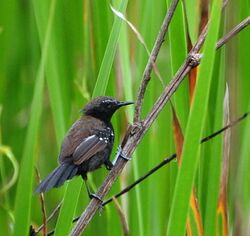Biology:Marsh antwren
| Marsh antwren | |
|---|---|

| |
| Male of the subspecies S. a. paludicola | |
| Scientific classification | |
| Domain: | Eukaryota |
| Kingdom: | Animalia |
| Phylum: | Chordata |
| Class: | Aves |
| Order: | Passeriformes |
| Family: | Thamnophilidae |
| Genus: | Formicivora |
| Species: | F. acutirostris
|
| Binomial name | |
| Formicivora acutirostris (Bornschein, Reinert & Teixeira, 1995)
| |
| Synonyms | |
|
Stymphalornis acutirostris | |
The marsh antwren (Formicivora acutirostris), also known as the Paraná antwren, is an insectivorous bird in the antbird family Thamnophilidae. It is endemic to marshes and swamps in the Brazil ian states of Paraná and Santa Catarina.
It was first described in 1995.[2] Although initially placed in its own genus Stymphalornis, a subsequently molecular phylogenetic study has shown that the marsh antwren is closely related to species in the genus Formicivora.[3]
It is threatened by habitat loss and currently considered Endangered by BirdLife International.[1]
Two subspecies are recognised:[4][1]
- F. a. acutirostris Bornschein, Reinert & Teixera, 1995 – Paraná to northeast Rio Grande do Sul
- F. a. paludicola (Buzzetti et al., 2013) – east São Paulo
The subspecies F. a. paludicola was discovered near São Paulo and described in 2013 as a new species in the genus Formicivora.[5] This subspecies has been found in fifteen small, isolated areas in the east of the state of São Paulo, not far from the city of São Paulo, in south-eastern Brazil. The sites lie within the headwaters of the Paraíba do Sul and Tietê Rivers, at elevations of 600–760 m (1,970–2,490 ft). There it inhabits marshes with relatively tall (60–250 cm (24–98 in)) vegetation. Much of its habitat is degraded and threatened by agricultural, industrial and residential development.[5]
Males of the subspecies F. a. paludicola can be distinguished from those of the nominate subspecies by their black underparts and thighs, very dark grey-brown upperparts, and a smaller exposed culmen. Females are distinguished by their very dark grey-brown upperparts and flanks, and smaller exposed culmen.[5]
The fourth edition of the Howard and Moore Complete Checklist of the Birds of the World and the online edition of the Handbook of the Birds of the World both treat the two subspecies as separate species and place them in the genus Formicivora. In their treatment Formicivora acutirostris is given the English name "Parana antwren" and Formicivora paludicola the name "marsh antwren".[6][7][8]
The suspended cup-shaped nest is made of dry vegetation. It is usually attached to reeds or grasses at a height of between 40 and 130 cm (16 and 51 in) above the ground. The clutch is two white eggs which have irregular brown blotches. The average size is 18.9 by 14.0 mm (0.74 by 0.55 in) with a weight of around 1.8 g (0.063 oz).[9]
References
- ↑ 1.0 1.1 1.2 BirdLife International (2019). "Formicivora acutirostris". IUCN Red List of Threatened Species 2019: e.T22724477A156172606. doi:10.2305/IUCN.UK.2019-3.RLTS.T22724477A156172606.en. https://www.iucnredlist.org/species/22724477/156172606. Retrieved 14 November 2021.
- ↑ Bornschein, M.R.; Reinert, B.L.; Teixeira, D.M. (1995) (in pt). Um novo Formicariidae do Sul do Brasil (Aves, Passeriformes). Publicação Técnico-Científica do Instituto Iguaçu de Pesquisa e Preservação Ambiental. 1. Rio de Janeiro, Brasil: Instituto Iguaçu de Pesquisa e Preservação Ambiental. pp. 1–18. https://www.researchgate.net/publication/320719907.
- ↑ Bravo, G.A.; Remsen, J.V.; Brumfield, R.T. (2014). "Adaptive processes drive ecomorphological convergent evolution in antwrens (Thamnophilidae)". Evolution 68 (10): 2757–2774. doi:10.1111/evo.12506. PMID 25135629. https://digitalcommons.lsu.edu/cgi/viewcontent.cgi?article=1523&context=biosci_pubs.
- ↑ Gill, Frank; Donsker, David, eds (2018). "Antbirds". World Bird List Version 8.1. International Ornithologists' Union. http://www.worldbirdnames.org/bow/antbirds/.
- ↑ 5.0 5.1 5.2 Buzzetti, D.R.C.; Belmonte-Lopes, R.; Reinert, B.L.; Silveira, L.F.; Bornschein, L.R. (2013). "A new species of Formicivora Swainson, 1824 (Thamnophilidae) from the state of São Paulo, Brazil". Revista Brasileira de Ornitologia 21 (4): 269–291. http://www4.museu-goeldi.br/revistabrornito/revista/index.php/BJO/article/viewFile/5409/pdf_860. Retrieved 2018-03-06.
- ↑ The Howard & Moore Complete Checklist of the Birds of the World. 2: Passerines (4th ed.). Eastbourne, UK: Aves Press. 2014. p. 72. ISBN 978-0-9568611-2-2.
- ↑ Zimmer, K.; Isler, M.L.; de Juana, E. (2018). "Parana Antwren (Formicivora acutirostris)". in del Hoyo, J.; Elliott, A.; Sargatal, J. et al.. Handbook of the Birds of the World Alive. Lynx Edicions. https://www.hbw.com/node/56770.
- ↑ Kirwan, G.M. (2018). "Marsh Antwren (Formicivora paludicola)". in del Hoyo, J.; Elliott, A.; Sargatal, J. et al.. Handbook of the Birds of the World Alive. Lynx Edicions. https://www.hbw.com/node/937322.
- ↑ Reinert, B.L.; Belmonte-Lopes, R.; Bornschein, M.R.; Sobotka, D.D.; Corrêa, L.; Pie, M.R.; Pizo, M.R. (2012). "Nest and eggs of the Marsh Antwren (Stymphalornis acutirostris): the only marsh-dwelling Thamnophilid". Wilson Journal of Ornithology 124 (2): 286–291. doi:10.1676/11-099.1.
External links
- Belmonte-Lopes, R.; Reinert, B.L.; Silveira, L.F. (November 2015). "Proposal (693): Recognize Formicivora paludicola as a valid species". South American Classification Committee of the American Ornithological Society. http://www.museum.lsu.edu/~Remsen/SACCprop693.htm.
- BirdLife Species Factsheet.
Wikidata ☰ Q780693 entry
 |


